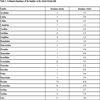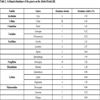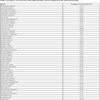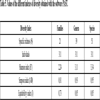- Home
- About Journals
-
Information for Authors/ReviewersEditorial Policies
Publication Fee
Publication Cycle - Process Flowchart
Online Manuscript Submission and Tracking System
Publishing Ethics and Rectitude
Authorship
Author Benefits
Reviewer Guidelines
Guest Editor Guidelines
Peer Review Workflow
Quick Track Option
Copyediting Services
Bentham Open Membership
Bentham Open Advisory Board
Archiving Policies
Fabricating and Stating False Information
Post Publication Discussions and Corrections
Editorial Management
Advertise With Us
Funding Agencies
Rate List
Kudos
General FAQs
Special Fee Waivers and Discounts
- Contact
- Help
- About Us
- Search

The Open Ornithology Journal
(Discontinued)
ISSN: 1874-4532 ― Volume 13, 2020
Bird Survey of the Abobo-Etetak Hill (Yaounde, Cameroon) and a Glance on the Avifaunistic Diversity of this Hill (Abobo-Etetak)
Billy Nguembock1, 2, *, Mahamat Sali1, Kemtchouan William1, Azang Esther Diane Olivia1, Guehoada Yollande1, Factheu Clinton1, Nkingop Djopmou Philippe Herve1
Abstract
Introduction:
We conducted a preliminary bird survey in the Abobo-Etetak hill (Yaounde, Cameroon).
Methods:
To carry out this survey, we used the mist-netting method and we captured birds over a period of six months. To study the distribution of this avifauna in their life environment, we performed several analyses to obtain various diversity indexes such as implemented in softwares SAS/STAT and PAST.
Results:
Three hundred and eleven individuals were captured belonging to 21 passerine and non-passerine families distributed into 39 genera and 51 species. We recorded new species for the area: Anthus brachyurus, Cinnyris reichenowi, Euplectes gierowii, Hirundo fuligula, Nicator vireo, Pogoniulus atroflavus and Pogoniulus subsulphureus, and Terpsiphone rufocinerea. Species documented were from the families Lybiidae, Motacillidae, Nectariniidae, Hirundinidae, Nicatoridae, Ploceidae and Monarchidae. Species from two new genera were recorded, Cinnyris (Sunbirds) and Terpsiphone (Monarchs). Estimated diversity index values show that the Abobo-Etetak hill exhibits high avifaunistic diversity.
Conclusion:
Our results found an absence of the supremacy of one species (H’=3.34) and the value of the Equitability index (J’=0.85) suggests an equal distribution of the individuals across species. With the obtained value of the index of Simpson diversity of 0.95, our result suggests high diversity within the Abobo-Etetak avifauna, which could be explained by luxuriant vegetation that is present all year round. Human activities have had an impact on the diversity of this avifauna with the presence of some genera sampled (Ploceus, Passer, Estrilda, Pycnonotus and Spermophaga) but the relic Centre Region of Cameroon which preserves its originality offers on the whole favourable conditions to birds.
Article Information
Identifiers and Pagination:
Year: 2017Volume: 10
First Page: 31
Last Page: 41
Publisher Id: TOOENIJ-10-31
DOI: 10.2174/1874453201710010031
Article History:
Received Date: 25/10/2016Revision Received Date: 29/12/2016
Acceptance Date: 09/01/2017
Electronic publication date: 31/03/2017
Collection year: 2017
open-access license: This is an open access article distributed under the terms of the Creative Commons Attribution 4.0 International Public License (CC-BY 4.0), a copy of which is available at: https://creativecommons.org/licenses/by/4.0/legalcode. This license permits unrestricted use, distribution, and reproduction in any medium, provided the original author and source are credited.
* Address correspondence to this author at the Département de Biologie et Physiologie Animales, Université de Yaoundé I, BP 812 Yaoundé, Cameroun, Université de Montréal, C.P. 6128, succursale du Centre-ville, Montréal, QC, H3C 3J7, Canada; Tel: +237694144294; E-mail: billyngue@yahoo.fr
| Open Peer Review Details | |||
|---|---|---|---|
| Manuscript submitted on 25-10-2016 |
Original Manuscript | Bird Survey of the Abobo-Etetak Hill (Yaounde, Cameroon) and a Glance on the Avifaunistic Diversity of this Hill (Abobo-Etetak) | |
INTRODUCTION
Cameroon is a country in West Africa in the great Congo Basin. It covers an area of approximately 475 440 sq. km with a latitudinal widespread of the Equatorial forest in the South to Sahelian areas of the Lake Chad in the Extreme North which shows several major habitats for birds.
However, in its diversity, Cameroon is subdivided into several vegetation regions from the coast to the Lake Chad the Mangrove and the Beach, the Equatorial forest, the Forest-savanna mosaic, the Adamawa Plateau, the Benue Plain, Mandara mountains, Sahel, Inundation area and the Montane district which often represent food areas for many birds.
Due to this diversity which provides habitats for different wildlife, Cameroon abounds in more than ten National Parks (for instance Korup National Park, Lobeke National Park, etc.) and eight nature reserve (for instance Dja faunal Reserve, Lake Ossa Reserve, etc.) which serve to protect and conserve the wealth of the Nature in the second world reserve of the biodiversity. These reserves and parks are distributed in the ten administrative regions among them the Centre Region in which is located the Yaounde city with its remarkable Zoo of Mvog-Betsi. The Yaounde city is established on a network of several mounts and shows a particularity with a mix of vegetation between the Equatorial forest and the Montane district in low altitude [1Louette M. The birds of Cameroon: An annoted check-list. Verhandeling Wetenschappen. Jaargang 1981; 43: 1-163.]. Thus, the general wildlife of the Yaounde city arouses a great attention as well as a large scientific interest since several years [2Amiet JL, Perret JL. Contribution à la faune de la région de Yaoundé (Cameroun). II Amphibiens Anoures. Ann Fac Sci Cameroun 1969; 3: 117-37.].
From then onwards, first surveys signalling this Region date back to the beginning of the twentieth century with [3Sharpe RB. On further collections of birds from the efulen district of cameroon, west africa, part II. Ibis 1904; 46(4): 591-638.
[http://dx.doi.org/10.1111/j.1474-919X.1904.tb00524.x] -5Bates GL. Anthreptes seimundi minor. Sanaga River, north of Yaounde, Cameroon. Bull Brit Orn Club 1926; 46: 107.] and recently [1Louette M. The birds of Cameroon: An annoted check-list. Verhandeling Wetenschappen. Jaargang 1981; 43: 1-163., 6Good AI. The birds of French Cameroon. Mém IFAN, Centre du Cameroun 1953; 1(1): 269. Sci. Nat. 1952; 2: 1-203, 7Germain M, Dragesco J, Roux F, Garcin H. Centre ORSTOM de Yaoundé, Université du Cameroun. Paris: Muséum National d'Histoire Naturelle 1974; pp. 212-59.]. These studies performed in the Centre Region of Cameroon permitted to identify several passerines families including Pittidae, Motacillidae, Timaliidae, Pycnonotidae, Muscicapidae, Hirundinidae, Campephagidae, Dicruridae, Laniidae, Corvidae, Sturnidae, Picathartidae, Nectariniidae, Fringillidae, Emberizidae, Ploceidae, etc. as well as several non-passerine families including Alcedinidae, Columbidae, Cuculidae, Meropidae, Coliidae, etc [2Amiet JL, Perret JL. Contribution à la faune de la région de Yaoundé (Cameroun). II Amphibiens Anoures. Ann Fac Sci Cameroun 1969; 3: 117-37., 6Good AI. The birds of French Cameroon. Mém IFAN, Centre du Cameroun 1953; 1(1): 269. Sci. Nat. 1952; 2: 1-203-10Fotso R, Dowsett-Lemaire F, Dowsett RJ, Scholte P, Languy M, Bowden C. Cameroon in important bird areas of Africa and associated islands: priority sites for conservation. In: Fishpool LDC, Evans MI, Eds. Birdlife Conservation Series N°11. Newbury and Cambridge, UK: Pisces Publications and Birdlife International 2001; pp. 133-59.]. Some studies had thus permitted to describe several new specimens from the Yaounde city in its mountains always well conserved even with the urbanization [3Sharpe RB. On further collections of birds from the efulen district of cameroon, west africa, part II. Ibis 1904; 46(4): 591-638.
[http://dx.doi.org/10.1111/j.1474-919X.1904.tb00524.x] -5Bates GL. Anthreptes seimundi minor. Sanaga River, north of Yaounde, Cameroon. Bull Brit Orn Club 1926; 46: 107.]. We only noted that these studies did not focus on diverse districts of the Yaounde city among which the Abobo-Etetak hill is included.
The Abobo-Etetak hill, in which we did our survey, is a hillside of the Mount Messa which is lengthened on diverse districts of the Yaounde city. The Abobo-Etetak hill is situated in a part of the Oyomabang district. It is limited in North by Carriere district, in West by Afeme Nord district, in East by Abobo district and South by Oyomabang district. Geographically, the Abobo-Etetak hill is situated in the Southeastern Plateau in the forest belt. As the rest of the Centre Region, the climate is characterized by elevated average monthly temperatures as well as a high level of the precipitations during the year [11Olivry JC. Fleuves et rivières du Cameroun Monographies hydrologiques Mesres/Orstom 9, Paris: Messes-Orstom. 1986; p. 733., 12Suchel JB. Les climats du Cameroun. Thèse de Doctorat d’Etat, Tome III 1988; 793-1187.]. Located in the Equatorial forest, the Abobo-Etetak hill shows different kinds of vegetation as sub-mountane forest, secondary forest intermixed with scrub land and riverine vegetation [11Olivry JC. Fleuves et rivières du Cameroun Monographies hydrologiques Mesres/Orstom 9, Paris: Messes-Orstom. 1986; p. 733.]. Otherwise, human activities have also degraded this area.
More generally until now, avifaunistic studies performed in the Yaounde city did not particularly investigate the avifaunistic diversity of the sites in which birds have been caught and yet, there is a correlation between the food areas and the presence or absence of birds [13Parsons H, Major RE, French K. Species interactions and habitat associations of birds inhabiting urban areas of Sydney, Australia. Austral Ecol 2006; 31: 217-27.
[http://dx.doi.org/10.1111/j.1442-9993.2006.01584.x] ]. Thus, expressed through a diversity index, a quantitative measure could reflect for instance how many different taxa (families, genera, species, etc.) are in a dataset, and simultaneously takes into account how evenly the basic entities (individuals) are distributed among those taxa [14Shannon CE. A mathematical theory of communication. Bell System Tech J 1948; 27: 379-423. pp: 623-56., 15Simpson EH. Measurement of diversity. Nature 1949; 163: 41-8-688.
[http://dx.doi.org/10.1038/163688a0] ].
In this study, which was realized in the Abobo-Etetak hill during eight months, we mainly followed two aims: firstly, we thoroughly investigated the avifauna of this hill from base to tip and secondly, we tried to understand the distribution of this avifauna in their life environment.
METHODS
Investigation of the Abobo-Etetak Avifauna
In order to investigate the avifauna, we used an appropriate method: the mist-netting method. According to this method, an inconspicuous mesh net is erected vertically on poles and deployed in areas of high activity to intercept birds as they go about their normal daily routines (Fig. 1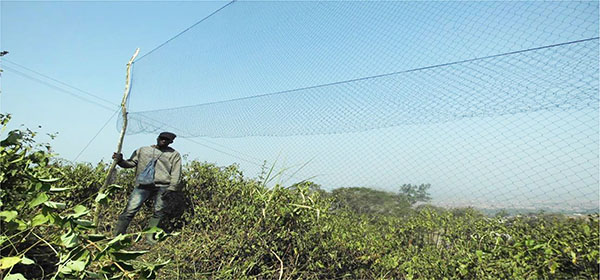 ).
).
We used dark-coloured nylon nets and smaller mesh for smaller species. Our mist nets were fixed with the mounting poles which were chosen carefully and the choice of an appropriate mist-netting site was important for the capture success (Fig. 1 ). To ensure the capture success, we mainly identified their preferred flight paths, feeding areas, roosting and shaded sites and that along the hill from the base to tip.
). To ensure the capture success, we mainly identified their preferred flight paths, feeding areas, roosting and shaded sites and that along the hill from the base to tip.
We began our capture very early in the morning (5: 00 AM) and we finished very late in the evening (sometimes 6: 30 PM). We used the same eight mist nets in our different field study and we did nine field studies during eight months.
 |
Fig. (1) Basic set-up of a mist net placed on a side of the Abobo-Etetak hill. |
Method for the Calculation of the Relative Abundance of the Abobo-Etetak Avifauna
In order to calculate the relative Abundance, we considered to use the Statistical Analysis System [16 SAS Institute. SAS/STAT guide for personal computers. 6th ed. Cary, NC 1985.]. Otherwise, we used a software program Excel to obtain our histograms and curves [17Microsoft Excel. Microsoft® Office Excel 2010.].
Method for the Calculation of the Occurrence of the Abobo-Etetak Avifauna
In order to calculate the occurrence, we used the same software, the Statistical Analysis System [16 SAS Institute. SAS/STAT guide for personal computers. 6th ed. Cary, NC 1985.]. The obtained results are frequencies as well as graphics.
Method for the Measure of the Distribution of the Abobo-Etetak Avifauna in Keeping with their Environment
Shannon Index (H’)
The Shannon’s diversity index represents the measure of the sum of degree of the uncertainty when it suggests predicting to which species would belong to an individual taken by chance in a collection of S species and N individuals. H’ = 0 if the community has only one species; H’ takes the maximal value log2S only when all species are represented by the same number of individuals. This index is determined by the relationship:
 |
Where pi = proportion of the individuals of the species “i”; S = total number of species of environment.
The Shannon index (H’) increases when the number of the species of the community grows and, theoretically, it can reach elevated values. The value of H’ varies from 1 to log2S. In our study, the Shannon index was calculated with the Software PAST [18Pearson TH, Rosenberg R. Macrobenthic succession in relation to organic enrichment and pollution of marine environment. Oceanogr Mar Biol (an Annual Review) 1978; 16: 229-311.].
Simpson Index (λ)
The Simpson index represents the proportion of abundance of the species “i” [18Pearson TH, Rosenberg R. Macrobenthic succession in relation to organic enrichment and pollution of marine environment. Oceanogr Mar Biol (an Annual Review) 1978; 16: 229-311.]. This index measures the degree of concentration when individuals are classified into types. It is determined by the relationship:
 |
Where ni = number of individuals of the species “i”; n = total number of the individuals of the sample.
Nevertheless, the most popular of such indexes have been the inverse Simpson index (1/λ) and the Gini-Simpson index (1 – λ) and both have also been called the Simpson index in the ecological literature. In our study, the Simpson index was calculated with the Software PAST [18Pearson TH, Rosenberg R. Macrobenthic succession in relation to organic enrichment and pollution of marine environment. Oceanogr Mar Biol (an Annual Review) 1978; 16: 229-311.].
Equitability Index
The Equitability index measures the distribution of the individuals within species independently to the specific richness. Its value varies from 0 (supremacy of one species) to 1 (equal distribution of the individuals in species).
Thus, the Equitability index of Pielou (J’) is determinated by the formula:
J’ = H’/H’ max
H’ = Shannon index
H’ max = log2 S (S = the total number of the species).
In our study, the Equitability index was calculated with the Software PAST [18Pearson TH, Rosenberg R. Macrobenthic succession in relation to organic enrichment and pollution of marine environment. Oceanogr Mar Biol (an Annual Review) 1978; 16: 229-311.].
All these indexes have been obtained with a confidence threshold of 95%.
RESULTS
Abundance and Occurrence of the Abobo-Etetak Avifauna
Familial Abundance of the Abobo-Etetak Avifauna
We caught 311 individuals belonging to 21 birds’ families (Table 1). The most representative family is the Ploceidae family with 119 of the 311 individuals (38.26%) with the Pycnonotidae family being second most abundant (14.79%; Table 4 and Fig. (2 )). We found that 84.55% of the captures were from Passerine families and 15.45% from Non-Passerine families (Table 1). The Ploceidae family was represented by four genera and eight species whereas the Pycnonotidae family was represented in the Abobo-Etetak avifauna by four genera and six species.
)). We found that 84.55% of the captures were from Passerine families and 15.45% from Non-Passerine families (Table 1). The Ploceidae family was represented by four genera and eight species whereas the Pycnonotidae family was represented in the Abobo-Etetak avifauna by four genera and six species.
 |
Fig. (2) Histogram of the relative abundances of the families captured in the Abobo-Etetak hill and species and genera number curves. |
Generic Abundance and Occurrence of the Abobo-Etetak Avifauna
311 individuals were captured which belong to 39 genera (Table 2). Within the Abobo-Etetak avifauna, the representative genera are Ploceus (16.72%), Euplectes (10.29%) and Quelea (9.32%) which are members of the Ploceidae family (Table 2 and Fig. (3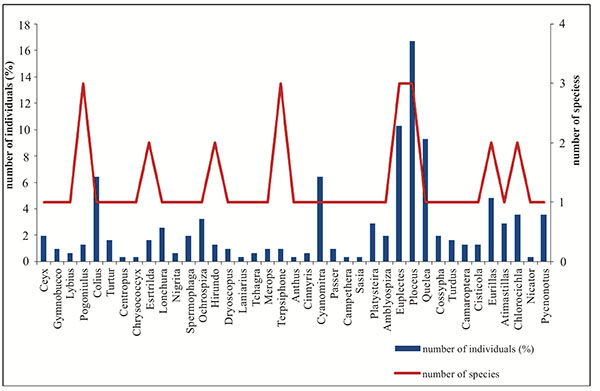 )). These genera are followed by Cyanomitra (6.43%) (Nectariniidae family), Colius (6.43%) (Coliidae family) and Eurillas (4.82%) (Pycnonotidae family) (Table 2 and Fig. (3
)). These genera are followed by Cyanomitra (6.43%) (Nectariniidae family), Colius (6.43%) (Coliidae family) and Eurillas (4.82%) (Pycnonotidae family) (Table 2 and Fig. (3 )). The less represented genera (relative abundance < 0.50%) are mainly the non-passerine members (Centropus, Chrysococcyx, Campethera, Sasia) (Table 2).
)). The less represented genera (relative abundance < 0.50%) are mainly the non-passerine members (Centropus, Chrysococcyx, Campethera, Sasia) (Table 2).
The majority of the genera (52.63%) captured on the Abobo-Etetak hill were rare (25% > FO ≥ 10%) (Table 3). However within the most representative family, the Ploceidae family, the genus Ploceus appeared very frequent on the Abobo-Etetak hill with a frequency of occurrence of 100% (Table 3). According to our results, except the genus Ploceus, two other genera have been frequent on the Abobo-Etetak hill, Cyanomitra (FO = 100%) and Colius (FO = 88.89) (Table 3).
 |
Fig. (3) Histogram of the relative abundances of the genera captured in the Abobo-Etetak hill and species number curve. |
Specific Occurrence of the Abobo-Etetak Avifauna
According to our occurrence results, only 5.88% of the birds captured are relatively common on the Abobo-Etetak hill, including the passerine members Cyanomitra verticalis (FO = 100%) and Ploceus nigricollis (FO = 88.88%), and the non-passerine member Colius striatus (FO = 88.88%) (Table 4). Species (21.57%) less commonly encountered included Platysteira cyanea (FO = 44.44%), Eurillas virens (FO = 44.44%), Eurillas latirostris (FO = 33.33%), Chlorocichla falkensteini (FO = 44.44%), Dryoscopus senegalensis (FO = 33.33%), Estrilda nonnula (FO = 33.33%), Euplectes ardens (FO = 33.33%), Ochrospiza mozambica (FO = 33.33%), Passer griseus (FO = 33.33%), Quelea erythrops (FO = 33.33%) and Turdus pelios (FO = 33.33%) (Table 4). In return, our analyses show clearly that the major part of the species (62.74%) sampled on the Abobo-Etetak hill were rare (25% > FO ≥ 10%) (Table 4).
Diversity Index
The Shannon index was 2.24 at the familial level, 3.11 at the generic level and 3.34 at the specific level (Table 5).
The Simpson index values were of 0.81 at the familial level, of 0.93 at the generic level and of 0.95 at the specific level (Table 5). As for the Shannon index, the general tendency is the same as the Simpson index with the obtained values which are also high (Table 5).
The equitability index values were 0.73 at the familial level, 0.85 at the generic level and 0.85 at the specific level (Table 5). As for the two first indexes, the obtained values also appear far from 0 (Table 5).
DISCUSSION
Avifauna of the Abobo-Etetak Hill
The survey accomplished on the Abobo-Etetak hill permits to highlight that Passerines birds were the most representative birds in this area with regard to Non-Passerines birds. Our study moves toward several surveys performed in Cameroon [1Louette M. The birds of Cameroon: An annoted check-list. Verhandeling Wetenschappen. Jaargang 1981; 43: 1-163., 6Good AI. The birds of French Cameroon. Mém IFAN, Centre du Cameroun 1953; 1(1): 269. Sci. Nat. 1952; 2: 1-203, 7Germain M, Dragesco J, Roux F, Garcin H. Centre ORSTOM de Yaoundé, Université du Cameroun. Paris: Muséum National d'Histoire Naturelle 1974; pp. 212-59.].
We found that 84,55% of birds captured were passerines and 15,45% of birds were non-passerines (Tables 1 and Fig. (2 )). Among these non-passerines, some families (Lybiidae, Meropidae, Alcedinidae, Columbidae, Cuculidae, Coliidae and Picidae) have been indicated in the relic Centre Region of Cameroon (Yaounde) but other passerine families (Pycnonotidae, Cisticolidae, Nectariniidae, Estrildidae, Ploceidae, Platysteiridae, Turdidae, Hirundinidae, Malaconotidae and Passeridae) have been already found in this Region [1Louette M. The birds of Cameroon: An annoted check-list. Verhandeling Wetenschappen. Jaargang 1981; 43: 1-163., 6Good AI. The birds of French Cameroon. Mém IFAN, Centre du Cameroun 1953; 1(1): 269. Sci. Nat. 1952; 2: 1-203, 7Germain M, Dragesco J, Roux F, Garcin H. Centre ORSTOM de Yaoundé, Université du Cameroun. Paris: Muséum National d'Histoire Naturelle 1974; pp. 212-59.].
)). Among these non-passerines, some families (Lybiidae, Meropidae, Alcedinidae, Columbidae, Cuculidae, Coliidae and Picidae) have been indicated in the relic Centre Region of Cameroon (Yaounde) but other passerine families (Pycnonotidae, Cisticolidae, Nectariniidae, Estrildidae, Ploceidae, Platysteiridae, Turdidae, Hirundinidae, Malaconotidae and Passeridae) have been already found in this Region [1Louette M. The birds of Cameroon: An annoted check-list. Verhandeling Wetenschappen. Jaargang 1981; 43: 1-163., 6Good AI. The birds of French Cameroon. Mém IFAN, Centre du Cameroun 1953; 1(1): 269. Sci. Nat. 1952; 2: 1-203, 7Germain M, Dragesco J, Roux F, Garcin H. Centre ORSTOM de Yaoundé, Université du Cameroun. Paris: Muséum National d'Histoire Naturelle 1974; pp. 212-59.].
Thus, this study permits to highlight new families in the relic Centre Region of Cameroon and particularly in the Abobo-Etetak hill. Comparatively to previous records, we newly recorded species representatives of the non-passerines families (Lybiidae) as well as the passerines families (Motacillidae, Nectariniidae, Hirundinidae, Nicatoridae, Ploceidae and Monarchidae) in this area (Table 1). Within the Abobo-Etetak avifauna, the most representative family is the Ploceidae family (Table 1 and Fig. 2 ). The Ploceidae family commonly called ‘weavers’ gets this name because of their meticulously woven nests; these small passerine birds are gregarious, breed colonially and occur in several habitats (woodland, forests, forest edge, lowland forests, wet habitats, gardens, open or semi-open habitats, human habitation, grassland, etc.) [19Hall BP, Moreau RE. An Atlas of speciation in African passerine birds: Trustees of the British Museum (Natural History). London 1970., 20Fry CH, Keith S. The birds of Africa. London: Christopher Helm, Vol. 7, 2004.]. Contrary to several other passerine families, their closest relatives still remain unknown and a future study in keeping with their phylogeny is long-awaited.
). The Ploceidae family commonly called ‘weavers’ gets this name because of their meticulously woven nests; these small passerine birds are gregarious, breed colonially and occur in several habitats (woodland, forests, forest edge, lowland forests, wet habitats, gardens, open or semi-open habitats, human habitation, grassland, etc.) [19Hall BP, Moreau RE. An Atlas of speciation in African passerine birds: Trustees of the British Museum (Natural History). London 1970., 20Fry CH, Keith S. The birds of Africa. London: Christopher Helm, Vol. 7, 2004.]. Contrary to several other passerine families, their closest relatives still remain unknown and a future study in keeping with their phylogeny is long-awaited.
We found two new genera until now not encountered in this relic Centre Region, Cinnyris (the Nectariniidae family) and Terpsiphone (the Monarchidae family) (Table 2). Except for these genera, most genera we found have been already recorded in this Region [1Louette M. The birds of Cameroon: An annoted check-list. Verhandeling Wetenschappen. Jaargang 1981; 43: 1-163., 6Good AI. The birds of French Cameroon. Mém IFAN, Centre du Cameroun 1953; 1(1): 269. Sci. Nat. 1952; 2: 1-203, 7Germain M, Dragesco J, Roux F, Garcin H. Centre ORSTOM de Yaoundé, Université du Cameroun. Paris: Muséum National d'Histoire Naturelle 1974; pp. 212-59.]. Among the genera met in this relic area, the genera Ploceus and Cyanomitra have obtained an occurrence frequency of 100% (Table 2). The genus Ploceus is a representative of the Ploceidae family (see above) and the genus Cyanomitra is a member of the Nectariniidae family; African sunbirds are very small passerine birds which feed on nectar but in their youth feed on insects [19Hall BP, Moreau RE. An Atlas of speciation in African passerine birds: Trustees of the British Museum (Natural History). London 1970., 21Borrow N, Demey R. Field Guide to the Birds of Western Africa London: Christopher Helm 2004., 22Fry CH, Keith S, Urban EK, Eds. The birds of Africa. London: Academic Press, Vol. 6, 2000.].
Concerning species representatives, our survey brings several new elements compared with the general avifauna known of this relic Centre Region (Table 4). Thus, seven of the 21 families listed show new representatives at the species’ level (Tables 1 and 4). Before our survey, these species were not mentioned in this relic Region: Anthus brachyurus (Motacillidae), Cinnyris reichenowi (Nectariniidae), Euplectes gierowii (Ploceidae), Hirundo fuligala (Hirundinidae), Nicator vireo (Nicatoridae), Pogoniulus atroflavus and Pogoniulus subsulphureus (Lybiidae) and Terpsiphone rufocinerea (Monarchidae) (Table 4). Otherwise, two species (Chlorocichla simplex and Campethera cailliautii) had been mentioned only in a district of Yaounde (Nsimalen) [7Germain M, Dragesco J, Roux F, Garcin H. Centre ORSTOM de Yaoundé, Université du Cameroun. Paris: Muséum National d'Histoire Naturelle 1974; pp. 212-59.].
Among species collected in this area, we noted a lot of sedentary birds which are rarely dispersed more than a few kilometres from their natal sites (Eurillas latirostris, Camaroptera brachyura, Turdus pelios, etc.), seasonal birds which appear only seasonally in another part (Anthus brachyurus and Chrysococcyx caprius), intra-African migrant birds which breed in one part of Africa and spend the post-breeding season in a different area (Ceyx pictus) and vagrant birds which are outside their normal range (Hirundo fuligula) (Table 4). Among the captured species, we highlighted two species of the Monarchidae family, the genus Terpsiphone, which are not found in the Guide [21Borrow N, Demey R. Field Guide to the Birds of Western Africa London: Christopher Helm 2004.] and they are probably new species; for this, we will do a molecular study in the future to clarify their situation.
Distribution and Diversity of the Avifauna in the Abobo-Etetak Hill Area
The Abobo-Etetak hill shows high avifaunistic diversity (see Table 5), with an absence of the supremacy of one species (H’ = 3.34; Table 5). According to some authors [2Amiet JL, Perret JL. Contribution à la faune de la région de Yaoundé (Cameroun). II Amphibiens Anoures. Ann Fac Sci Cameroun 1969; 3: 117-37., 23Heim De Balsac H. Contribution à la faune de la région de Yaoundé (Cameroun). I. Premier aperçu sur la faune des Soricidae (Mammifères Insectivores). Ann Fac Sci Ydé 1969; 2: 49-58.], the montane vegetation grows on hills near Yaounde (at elevations of only 800-900 metres) and these semi-montane biomes offer the same feeding favourable conditions for all birds visiting or living in this relic area. Otherwise, it is documented that the distribution of many tropical bird species is closely related to a particular vegetation type [1Louette M. The birds of Cameroon: An annoted check-list. Verhandeling Wetenschappen. Jaargang 1981; 43: 1-163.] and more generally a correlation between food areas and birds is well established [13Parsons H, Major RE, French K. Species interactions and habitat associations of birds inhabiting urban areas of Sydney, Australia. Austral Ecol 2006; 31: 217-27.
[http://dx.doi.org/10.1111/j.1442-9993.2006.01584.x] ]. The Abobo-Etetak hill appears with the same vegetation from base to tip (secondary forest with in some places farmland). The distribution of the Abobo-Etetak avifauna corroborates practically this principle with the obtained value of the Equitability index (J’= 0.85; Table 5) which establishes the equal distribution of the individuals inside species.
The Simpson diversity index of 0.95 (1 – D = 0.95; Table 5) shows that the diversity within the Abobo-Etetak avifauna is established and this result goes in the same direction that the absence of the supremacy of one species as well as the equal distribution of the individuals of the species. Thus, all obtained values show that the Abobo-Etetak avifauna appears diversified; the diversity of this avifauna could be explained by luxuriant vegetation in this relic area all year round and this would have been favoured by a lesser competition between the individuals living in this hill. Otherwise the transformation of this area by human activities (particularly farmland) would have had an impact on the diversity of this avifauna with some genera captured in this hill (Ploceus, Passer, Estrilda, Pycnonotus and Spermophaga).
Scientific Interest of the Abobo-Etetak Hill Area
Contrary to several African regions, this relic Centre Region shows the Montane district at very low altitude (an altitude of less of 800 to 900 metres) whereas generally it begins in other African regions at an altitude of 1600 to 1800 metres [1Louette M. The birds of Cameroon: An annoted check-list. Verhandeling Wetenschappen. Jaargang 1981; 43: 1-163., 2Amiet JL, Perret JL. Contribution à la faune de la région de Yaoundé (Cameroun). II Amphibiens Anoures. Ann Fac Sci Cameroun 1969; 3: 117-37., 24Nonnotte P. Etude volcano-tectonique de la zone de Divergence Nord Tanzanienne (Terminaison Sud du Rift Kenyan). Caractérisation pétrologique et géochimique du volcanisme récent (8 Ma-Actuel) et du manteau source. Contraintes de mise en place PhD Thesis. France: University of Western Bretagne 2007.-26Stuart SN. Conservation of Cameroon montane forests Report of the International Council for Bird Preservation. Cambridge, UK: ICBP 1986.]. Thus, several new and endemic species have been described [3Sharpe RB. On further collections of birds from the efulen district of cameroon, west africa, part II. Ibis 1904; 46(4): 591-638.
[http://dx.doi.org/10.1111/j.1474-919X.1904.tb00524.x] -5Bates GL. Anthreptes seimundi minor. Sanaga River, north of Yaounde, Cameroon. Bull Brit Orn Club 1926; 46: 107.] in this relic Region and certainly the two new taxa not found in the Guide [21Borrow N, Demey R. Field Guide to the Birds of Western Africa London: Christopher Helm 2004.] could be new species. Otherwise in spite of the urbanization as well as climatic changes, this Region preserves its originality in keeping with the fresh climate in an Equatorial area thus offering favourable conditions to birds all year around and receiving many European migrants’ birds during the winter.
LIST OF ABBREVIATIONS
| N | = North |
| E | = East |
| SAS/STAT | = Statistical Analysis System |
| PAST | = Paleontological Statistics |
| % | = Percentage |
| FO | = Frequency of occurrence |
CONFLICT OF INTEREST
The authors confirm that this article content has no conflict of interest.
ACKNOWLEDGEMENTS
We thank the chief of the Abobo-Etetak village, his majesty ENYEGUE, who permitted us to carry out this study. We wish to thank the guide, Sir Yannick, for all his efforts and his good knowledge of site which facilitated birds capture. We thank the zoology laboratory of the University of Yaounde I, especially the ornithology team for the technical material which has been used for the realization of this scientific work. We also wish to thank all persons, especially Sir OJONG Gaines who read this paper in order to ameliorate its quality through their scientific critics. Finally, authors are grateful to all the researchers who participated by near or by far to the accomplishment of this work. We also thank two anonymous reviewers for their comments that greatly improved the manuscript.
REFERENCES
| [1] | Louette M. The birds of Cameroon: An annoted check-list. Verhandeling Wetenschappen. Jaargang 1981; 43: 1-163. |
| [2] | Amiet JL, Perret JL. Contribution à la faune de la région de Yaoundé (Cameroun). II Amphibiens Anoures. Ann Fac Sci Cameroun 1969; 3: 117-37. |
| [3] | Sharpe RB. On further collections of birds from the efulen district of cameroon, west africa, part II. Ibis 1904; 46(4): 591-638. [http://dx.doi.org/10.1111/j.1474-919X.1904.tb00524.x] |
| [4] | Sharpe RB. On further collections of birds from the efulen district of cameroon, West Africa, Part V & VI. Ibis 1908; 46(9): p. 119. |
| [5] | Bates GL. Anthreptes seimundi minor. Sanaga River, north of Yaounde, Cameroon. Bull Brit Orn Club 1926; 46: 107. |
| [6] | Good AI. The birds of French Cameroon. Mém IFAN, Centre du Cameroun 1953; 1(1): 269. Sci. Nat. 1952; 2: 1-203 |
| [7] | Germain M, Dragesco J, Roux F, Garcin H. Centre ORSTOM de Yaoundé, Université du Cameroun. Paris: Muséum National d'Histoire Naturelle 1974; pp. 212-59. |
| [8] | Decoux JP, Fotso RC. Composition et organisation spatiale d’une communauté d’oiseaux dans la région de Yaoundé. Conséquences biogéographiques de la dégradation forestière et de l’aridité croissante. Alauda 1988; 56: 126-52. |
| [9] | Fotso RC. Notes sur les oiseaux d’eau de la région de Yaoundé. Malimbus 1990; 12: 25-30. |
| [10] | Fotso R, Dowsett-Lemaire F, Dowsett RJ, Scholte P, Languy M, Bowden C. Cameroon in important bird areas of Africa and associated islands: priority sites for conservation. In: Fishpool LDC, Evans MI, Eds. Birdlife Conservation Series N°11. Newbury and Cambridge, UK: Pisces Publications and Birdlife International 2001; pp. 133-59. |
| [11] | Olivry JC. Fleuves et rivières du Cameroun Monographies hydrologiques Mesres/Orstom 9, Paris: Messes-Orstom. 1986; p. 733. |
| [12] | Suchel JB. Les climats du Cameroun. Thèse de Doctorat d’Etat, Tome III 1988; 793-1187. |
| [13] | Parsons H, Major RE, French K. Species interactions and habitat associations of birds inhabiting urban areas of Sydney, Australia. Austral Ecol 2006; 31: 217-27. [http://dx.doi.org/10.1111/j.1442-9993.2006.01584.x] |
| [14] | Shannon CE. A mathematical theory of communication. Bell System Tech J 1948; 27: 379-423. pp: 623-56. |
| [15] | Simpson EH. Measurement of diversity. Nature 1949; 163: 41-8-688. [http://dx.doi.org/10.1038/163688a0] |
| [16] | SAS Institute. SAS/STAT guide for personal computers. 6th ed. Cary, NC 1985. |
| [17] | Microsoft Excel. Microsoft® Office Excel 2010. |
| [18] | Pearson TH, Rosenberg R. Macrobenthic succession in relation to organic enrichment and pollution of marine environment. Oceanogr Mar Biol (an Annual Review) 1978; 16: 229-311. |
| [19] | Hall BP, Moreau RE. An Atlas of speciation in African passerine birds: Trustees of the British Museum (Natural History). London 1970. |
| [20] | Fry CH, Keith S. The birds of Africa. London: Christopher Helm, Vol. 7, 2004. |
| [21] | Borrow N, Demey R. Field Guide to the Birds of Western Africa London: Christopher Helm 2004. |
| [22] | Fry CH, Keith S, Urban EK, Eds. The birds of Africa. London: Academic Press, Vol. 6, 2000. |
| [23] | Heim De Balsac H. Contribution à la faune de la région de Yaoundé (Cameroun). I. Premier aperçu sur la faune des Soricidae (Mammifères Insectivores). Ann Fac Sci Ydé 1969; 2: 49-58. |
| [24] | Nonnotte P. Etude volcano-tectonique de la zone de Divergence Nord Tanzanienne (Terminaison Sud du Rift Kenyan). Caractérisation pétrologique et géochimique du volcanisme récent (8 Ma-Actuel) et du manteau source. Contraintes de mise en place PhD Thesis. France: University of Western Bretagne 2007. |
| [25] | Nguembock B. Etude phylogénétique et biogéographique de l’avifaune forestière des montagnes de l’Ouest du Cameroun. PhD Thesis. France: University of Paris VI 2008. |
| [26] | Stuart SN. Conservation of Cameroon montane forests Report of the International Council for Bird Preservation. Cambridge, UK: ICBP 1986. |




